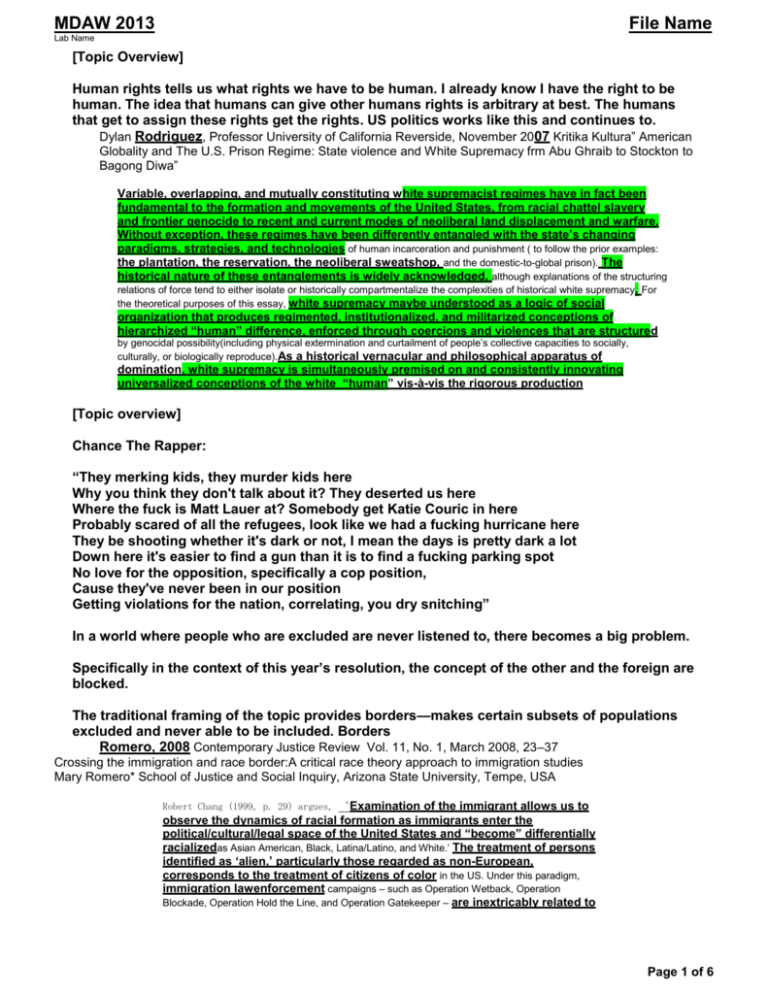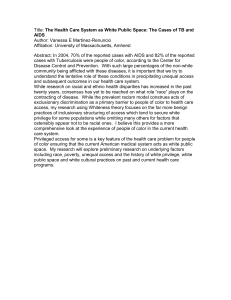
MDAW 2013
File Name
Lab Name
[Topic Overview]
Human rights tells us what rights we have to be human. I already know I have the right to be
human. The idea that humans can give other humans rights is arbitrary at best. The humans
that get to assign these rights get the rights. US politics works like this and continues to.
Dylan Rodriguez, Professor University of California Reverside, November 2007 Kritika Kultura” American
Globality and The U.S. Prison Regime: State violence and White Supremacy frm Abu Ghraib to Stockton to
Bagong Diwa”
Variable, overlapping, and mutually constituting white supremacist regimes have in fact been
fundamental to the formation and movements of the United States, from racial chattel slavery
and frontier genocide to recent and current modes of neoliberal land displacement and warfare.
Without exception, these regimes have been differently entangled with the state’s changing
paradigms, strategies, and technologies of human incarceration and punishment ( to follow the prior examples:
the plantation, the reservation, the neoliberal sweatshop, and the domestic-to-global prison). The
historical nature of these entanglements is widely acknowledged, although explanations of the structuring
relations of force tend to either isolate or historically compartmentalize the complexities of historical white supremacy. For
the theoretical purposes of this essay, white supremacy maybe understood as a logic of social
organization that produces regimented, institutionalized, and militarized conceptions of
hierarchized “human” difference, enforced through coercions and violences that are structured
by genocidal possibility(including physical extermination and curtailment of people’s collective capacities to socially,
culturally, or biologically reproduce). As a historical vernacular and philosophical apparatus of
domination, white supremacy is simultaneously premised on and consistently innovating
universalized conceptions of the white “human” vis-à-vis the rigorous production
[Topic overview]
Chance The Rapper:
“They merking kids, they murder kids here
Why you think they don't talk about it? They deserted us here
Where the fuck is Matt Lauer at? Somebody get Katie Couric in here
Probably scared of all the refugees, look like we had a fucking hurricane here
They be shooting whether it's dark or not, I mean the days is pretty dark a lot
Down here it's easier to find a gun than it is to find a fucking parking spot
No love for the opposition, specifically a cop position,
Cause they've never been in our position
Getting violations for the nation, correlating, you dry snitching”
In a world where people who are excluded are never listened to, there becomes a big problem.
Specifically in the context of this year’s resolution, the concept of the other and the foreign are
blocked.
The traditional framing of the topic provides borders—makes certain subsets of populations
excluded and never able to be included. Borders
Romero, 2008 Contemporary Justice Review Vol. 11, No. 1, March 2008, 23–37
Crossing the immigration and race border:A critical race theory approach to immigration studies
Mary Romero* School of Justice and Social Inquiry, Arizona State University, Tempe, USA
Robert Chang (1999, p. 29) argues, ‘Examination of the immigrant allows us to
observe the dynamics of racial formation as immigrants enter the
political/cultural/legal space of the United States and “become” differentially
racializedas Asian American, Black, Latina/Latino, and White.’ The treatment of persons
identified as ‘alien,’ particularly those regarded as non-European,
corresponds to the treatment of citizens of color in the US. Under this paradigm,
immigration lawenforcement campaigns – such as Operation Wetback, Operation
Blockade, Operation Hold the Line, and Operation Gatekeeper – are inextricably related to
Page 1 of 6
MDAW 2013
File Name
Lab Name
society’s view of citizens of, in this case, Mexican ancestry. Concern over
immigration to the US is inseparable from stereotyping Mexicans as ‘illegal aliens’
and socially constructing Mexicans as criminal, foreign, and the other. Although the law
institutionalizes who is ‘alien,’ the social construction of immigrant status is
not complete without policing and surveillance. The ‘show me your papers’ inspection
of passports, identification cards, and other forms of documentation, once associated with
totalitarian regimes, is now routinely used in the US to control access to social services, to
authorize and regulate movement, and to single out specific racial groups for additional citizenship
inspection (Caplan & Torpey, 2001). While branding and tattooing, or other forms of ‘writing on the
body,’ are not used to distinguish between ‘aliens’ and citizens, the practice of racial
profiling demonstrates that citizenship status is inscribed on the body.1 For
instance, the US Supreme Court decision in United States v. Brignoni-Ponce (1975) that ‘Mexican
appearance’ ‘constitutes a legitimate consideration under the Fourth Amendment for making an
immigration stop’ (K. Johnson, 2000, p. 676) sanctions the immigration law enforcement use of
racial profiling. Stigmatized as ‘aliens,’ Latinas/os and Asian Pacific Americans carry a
bodily ‘figurative border’ (Chang, 1999). Racialized immigration law-enforcement practices
allow a person’s appearance to serve as ‘reasonable suspicion’ or ‘probable cause.’ This
process of surveillance and citizenship inspection involves racial profiling;
persons are identified on the basis of their social identity– e.g., ‘Mexicanness’ –
rather than on the basis of specific behavior (Benitez, 1994; K. Johnson, 1996, 2000; Romero,
2006). Consequently, working-class Latinos are frequently the targets of racially motivated
detentions and searches, and thus far are more likely than middle-class Whites to encounter abuse
by the Immigration and Naturalization Service (INS) (Arriola, 1996; Benitez, 1994; Lazos, 2002;
Vargas, 2001).The likelihood of mistreatment of Mexican immigrants and
Mexican Americans increases with the routine use of racial profiling in
citizenship inspections. As Kevin Johnson (1996, p. 268) cautions, ‘Alien terminology helps
rationalize harsh, perhaps inhumane, treatment of persons from other countries.’ This is consistent
with Dunn’s (1996) finding that the ‘low intensity conflict doctrine,’ developed by United States
military theoreticians during the 1980s, has been applied to the US–Mexico border region. Nevins’s
(2002) account of hardships and the increasing control over human resources depicts the
significant harms and diminished opportunities that communities along the border experience under
Operation Gatekeeper.
narrative
We need to adopt a politics of culture not a culture of politics—adopting a culture of politics
just allows these continuing oppressions to happen. We can never escape the grammar of
suffering in a world where our grammar is always relegated to a typo.
Wilderson 10’( Frank Red White and Black: Cinema and the structure of U.S. Antagonisms) pg. 57
conceptual framework, predicated not on the subject-effect of cultural performance but
on the structure of political ontology, a framework that allows us to substitute a culture of politics for
a politics of culture. The value in this rests not simply in the way it would help us rethink cinema and performance, but in the way it can help us theorize what is at present only intuitive and
anecdotal: the unbridgeable gap between Black being and Human life. To put a finer point on it, such a framework might enhance the explanatory power of
theory, art, and politics by destroying and perhaps restructuring the ethical range of our current
ensemble of questions. This has profound implications for non-Black film studies, Black film studies, and African
American studies writ large because they are currently entangled in a multicultural paradigm that takes
an interest in an insufficiently critical comparative analysis— that is, a comparative analysis in
pursuit of a coalition politics (if not in practice then at least as a theorizing metaphor) which, by its
very nature, crowds out and forecloses the Slave's grammar of suffering.
I am calling for a different
Epistemic location matters – we can’t escape where we come from. Decolonial thinking is a
matter of interrogating and advancing a geo-politics of knowledge based on our own link to
subalternity – this is what their framework arguments forclose by definition
Grosfoguel,
Ramón, University of California, Berkeley, Decolonizing Post-Colonial Studies and Paradigms of Political-Economy: Transmodernity, Decolonial
11
Thinking, and Global Coloniality 20
TRANSMODERNITY: Journal of Peripheral Cultural Production of the Luso-Hispanic World, School of Social Sciences,
Humanities, and Arts, UC Merced http://escholarship.org/uc/item/21k6t3fq Tiana
Page 2 of 6
MDAW 2013
File Name
Lab Name
The first point to discuss is the contribution of racial/ethnic and feminist subaltern perspectives
to epistemological questions. The hegemonic Eurocentric paradigms that have informed
western philosophy and sciences in the “modern/colonial capitalist/patriarchal world-system”
(Grosfoguel 2005; 2006b) for the last 500 hundred years assume a universalistic, neutral, objective point of
view. Chicana and black feminist scholars (Moraga and Anzaldúa 1983; Collins 1990) as well as Third World scholars
inside and outside the United States (Dussel 1977) reminded us that we always speak from a particular location in the
power structures. Nobody escapes the class, sexual, gender, spiritual, linguistic, geographical, and
racial hierarchies of the “modern/colonial capitalist/patriarchal world-system“. As feminist scholar
Donna Haraway (1988) states, our knowledges are always situated. Black feminist scholars called this perspective “afrocentric epistemology” (Collins 1990) (which is not equivalent to the afrocentrist perspective) while Latin American
Philosopher of Liberation Enrique Dussel called it “geopolitics of knowledge” (Dussel 1977) and, following Fanon (1967)
and Anzaldúa (1987), I will use the term “bodypolitics of knowledge.” This is not only a question about social values in
knowledge production or the fact that our knowledge is always partial. The main point here is the locus of
enunciation, that is, the geo-political and body-political location of the subject that speaks. In
Western philosophy and sciences the subject that speaks is always hidden, concealed, erased
from the analysis. The “ego-politics of knowledge” of Western philosophy has always privilege
the myth of a non-situated “Ego”. Ethnic/racial/gender/sexual epistemic location and the subject
that speaks are always decoupled. By delinking ethnic/racial/gender/sexual epistemic location from the subject
that speaks, Western philosophy and sciences are able to produce a myth about a Truthful universal knowledge that covers
up, that is, conceals who is speaking as well as the geo-political and body-political epistemic location in the structures of
colonial power/knowledge from which the subject speaks. It is important here to distinguish the “epistemic
location” from the “social location.” The fact that one is socially located in the oppressed side
of power relations does not automatically mean that he/she is epistemically thinking from a
subaltern epistemic location. Precisely, the success of the modern/colonial worldsystem consists in making
subjects that are socially located in the oppressed side of the colonial difference, to think epistemically like the ones on the
dominant positions. Subaltern epistemic perspectives are knowledge coming from below that produces a critical
perspective of hegemonic knowledge in the power relations involved. I am not claiming an epistemic populism where
knowledge produced from below is automatically an epistemic subaltern knowledge. What I am claiming is that all
knowledges are epistemically located in the dominant or the subaltern side of the power
relations and that this is related to the geo- and body-politics of knowledge. The disembodied
and unlocated neutrality and objectivity of the ego-politics of knowledge is a Western myth. René
Descartes, the founder of Modern Western Philosophy, inaugurates a new moment in the history of Western thought. He
replaces God, as the foundation of knowledge in the Theo-politics of knowledge of the European Middle Ages, with
(Western) Man as the foundation of knowledge in European Modern times. All the attributes of God are now extrapolated to
(Western) Man. Universal Truth beyond time and space privileges access to the laws of the Universe, and the capacity to
produce scientific knowledge and theory is now placed in the mind of Western Man. The Cartesian “Cogito ergo sum” (“I
think, therefore I am“) is the foundation of modern Western sciences. By producing a dualism between mind and body and
between mind and nature, Descartes was able to claim non-situated, universal, Godeyed view knowledge. This is what the
Colombian philosopher Santiago CastroGómez called the “point zero” perspective of Eurocentric philosophies (CastroGómez 2003). The “point zero” is the point of view that hides and conceals itself as being beyond a particular point of view,
that is, the point of view that represents itself as being without a point of view. It is this “god-eye view” that always hides its
local and particular perspective under an abstract universalism. Western philosophy privileges “ego politics
of knowledge” over the “geopolitics of knowledge” and the “body-politics of knowledge.”
Historically, this has allowed Western man (the gendered term is intentionally used here) to
represent his knowledge as the only one capable of achieving a universal consciousness, and to
dismiss non-Western knowledge as particularistic and, thus, unable to achieve universality. This
epistemic strategy has been crucial for Western global designs. By hiding the location of the subject of enunciation ,
European/Euro-American colonial expansion and domination was able to construct a hierarchy
of superior and inferior knowledge and, thus, of superior and inferior people around the world
WHITENESS IS A PERFORMATIVE CONSTRUCT THAT MAINTAINS VARIOUS NETWORKS OF
OPPRESSION. PERFORMATIVE PEDAGOGY IS AN ACTIVE PROCESS OF DISMANTLING THE
WHITENESS AND PATRIARCHY INHERENT IN THE STATUS QUO. VOTING AFFIRMATIVE IS A
INTERRUPTION OF WHITENESS, ITS PERPETUATION AND MAKING VISCERAL AND
PRESENT ITS INVISIBLE NATURE.
Warren and Fassett, 2004The Johns Hopkins University Press. All rights reserved Theatre Topics 14.2 (2004)
411-430John T. Warren is an assistant professor in the School of Communication Studies at Bowling Green State
University, where he teaches courses in performance, culture, identity, and power. Deanna L. Fassett is an assistant
professor in the Department of Communication Studies at San José State University, where she teaches courses in
instructional communication and critical, feminist, and performative pedagogies.
In the last ten years,a variety of cross-disciplinary scholars have illuminated (and, in that effort, sought
to deconstruct) racial privilege and disadvantage by examining whiteness as a cultural, political
Page 3 of 6
MDAW 2013
File Name
Lab Name
location—as an identity created and maintained through our everyday communication.1 In some of
these studies, whiteness is revealed as a strategic rhetoric, a means by which people, working in
concert and often unreflectively, levy power and cultural influence.For example, communication and film
scholars examine rhetorical constructions of whiteness (see Crenshaw; Dyer; Nakayama and Krizek; Shome). While this
perspective may help us understand the role of language (and how social systems and
individuals work in concert to create racial oppression) recentefforts by scholars to maintain a
focus on the white subject have underscored the importance of deconstructing and challenging
white subjectivity in order to promote a more equitable and socially just society.Research here has
taken many forms. Critical scholars in theatre have led the way,creating critical performances of whiteness(see
Jackson; O'Brien; Warren and Kilgard) that function to mirror, particularly to white audiences, the
mechanisms and machinations of their oppressive actions, however unreflective . Ethnographic
portraits of whiteness have given depth and immediacy to our understandings of people in lived
context(Hartigan; hooks; Warren, Performing). Autoethnographers, because they plumb their
lived experience for particular details and contradictions about how they create and are created
by culture, have constituted a rich repository for the study of how each of us works to
understand his or her own ethnic identity(Clark and O'Donnell; Pelias; Warren, "Absence").Studies in
education have also created a critical context for understanding how whiteness permeates our
classrooms(see Giroux; Hytten and Adkins; McIntyre); such work functions to remind us of the power of
pedagogy to help us see and re-see the actions we take, challenge, or leave unquestioned.In an
earlier essay, one of us organized, from across the variety of disciplinary perspectives, four key scholarly approaches to
the study of whiteness to help create a nuanced understanding of thisseemingly inescapable and
overwhelmingpolitical and cultural thicket(Warren, "Whiteness"). First, scholars have analyzed whiteness in order to
promote antiracism.
Society inscribes identities on people based off of social location and what comes with this—
people are marked other based on their identities and marked off by texts and told that they
don’t belong. Being marked by blackness is not a pos
DSRB, GHETTO KIDS,pg 83, 2012
A close examination of UDL media coverage reveals more subtle and complex layers of meaning
embedded within the lines of human-interest stories. Through the lens of Jackson's theory of media
scripting, it is possible to highlight the manner in which the UDL news stories invite audiences to
embrace certain assumptions about inner-city youths, the debate activity, and the
representational politics of race and gender. The media framing of
black youths, given the significance of the black body in the U.S. social
narrative, does not determine but suggests available scripts from which to
make young black bodies intelligible. For this analysis, I am interested in the
inscription of corporeal bodies, the tangible surface of the body and its
material relation to other bodies in the social structure. Jackson (2006)
argues that the body is a "discursive text" that can be written and
rewritten upon (p. 7). This process of writing and rewriting the body
is bound by "prior inscriptions" of the body as a socio-historical
construct (Jackson, 2006, p. 7). Thus, the body is never free of inscriptions.
Inscriptions are always already a necessary condition of the
intelligibility of social bodies. The body carries certain markers
(like sex, race, and ethnicity) that are made intelligible through the
normative field of social interaction. Jackson (2006) notes: As with any theatrical
script, the script is the text, and the act of scripting is the writing of the text. Therefore, to
script someone else's body is to actively inscribe or figuratively
place one's self, worldview, or ascriptions onto another projected
text, which often requires dislocating the original text and
redefining the newly affected or mirrored text as the
counterpositional or oppositional Other. (p. 53) In other words, the
process of inscription is bound by the very social discourses that
bring a subject into being as black. This process of subjection
requires the repetition of certain scripts to maintain the
constitution of the subject as a racialized body. Scripting is a part
Page 4 of 6
MDAW 2013
File Name
Lab Name
of the very process of subjectification. Certain inscriptions have more discursive
purchase, as they coincide with other discourses and in relation to
other apparatuses of power-both institutional and cultural-that
produce and are produced by the process of subjection. For Jackson (2006^ in
order to understand how the scripting process functions in the
development of racial and gender stereotypes, one must look specifically to
the manner in which scripts are oveilaid on corporeal bodies to
signify otherness, especially in the process of dominant viewpoints asserting
themselves as natural, normalized perspectives. Within news frames about
poor urban communities of color, the frame often suggests the
available scripts by which bodies of color may be read based on
the social ideologies surrounding race, class, and gender within
U.S. society. The frame is a narrative container, it (en)frames particular
narrative foci. Although the frame is not deterministic, it (re)produces or (re)iterates
scripts that are intelligible for the intended audience. The process
of reiteration is critical because it is the incessant reproduction of
the script attached to bodies that allows particular scripts to take
hold of the social imagination (Gillbom, 2005, p. 490). Bodily inscriptions
inherently unstable, which is why it becomes necessary to repeat or reiterate such
inscriptions for the body to remain intelligible within specific kinds of frames. In this
context, Jackson's
(2006) concept of scripting is uniquely insightful
for this study as it accounts for how the black body is inscribed in
(and by) the public imagination, and it requires an interrogation of
the significance of the body as a means of making media scripts
intelligible. For Jackson, the body seems to function as a symbolic
device that interacts with the individual's prior knowledge of
certain kinds of bodies, particularly those bodies marked by
Otherness. Jackson's (2006) ar.alysis focuses on the scripting of the black male body in U.S.
popular culture, simultaneously situating popular discourse in articulation with racialized scripts
across various media. Jackson begins by
tracing the images of blackness in early
U.S. popular culture including Uncle Tom, Sambo, the Coon, the Buck,
the Jezebel, and the Tragic Mulatto, images that he argues chain out in
contemporary popular culture. He notes that there is an
interrelationship between historical images and narratives of
blackness and the scripting of black bodies through public
discourses. The negative discourses surrounding both black
culture and black bodies are birthed from early colonial and
imperial interaction with Africa. As European expansionism began
to seek control over African resources, the resulting colonial rule
of African nations and the development of the trans-Atlantic slave
trade required a discursive framing with which to justify
Europeans' and Euro-Americans' insouciance toward atrocity.
Characterizations of the black body and black culture as
abnormal, irrational, intellectually inferior, culturally deficient,
violent, licentious, and potentially criminal have permeated
colonial and post-colonial discourse about blackness. The
repetition of these inscriptions of blackness produces a discursive
field through which black bodies become intelligible to the social
imagination. It is not that the black body has no agency in responding to racialized
inscriptions. Those marked by blackness produce and are produced
Page 5 of 6
MDAW 2013
File Name
Lab Name
by these prior inscriptions. The black body, despite its agency, is confined
within the field of racialization. Particularly in the context of news media representation, the
black body has limited control over the scripting of the meanings
attached to and associated with blackness. Given that the news media
repetitively reuse specific framing practices in association with inner-city black youth, the
frame provides a conceptual limit on any attempt to reinscript the
bodies of black youths through transformative narratives. This essay,
therefore, is concerned with how the media recycle frames of black criminality,
familial dysfunction, cind intellectual inferiority to script subject
positions for the bodies of the black youths featured in inspirational humaninterest stories.
Page 6 of 6








